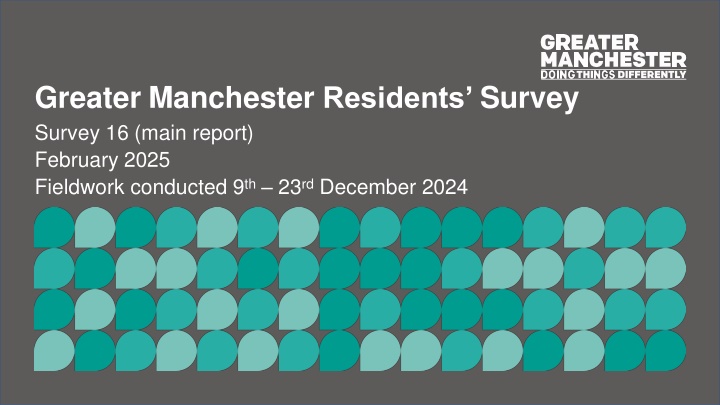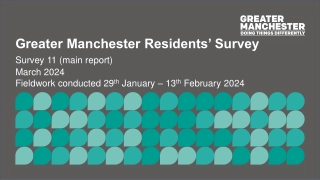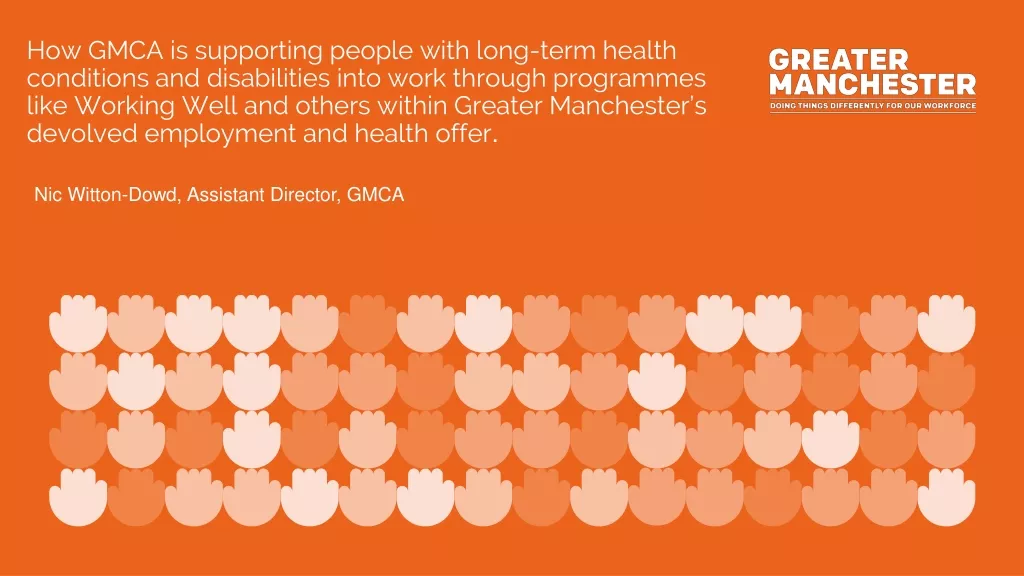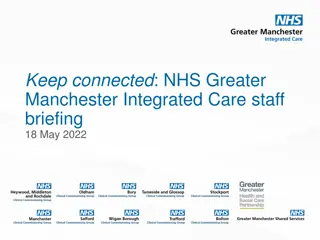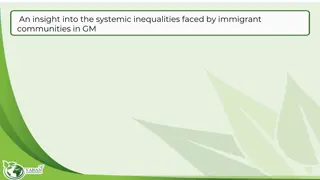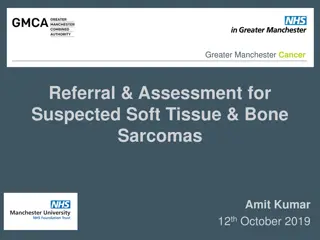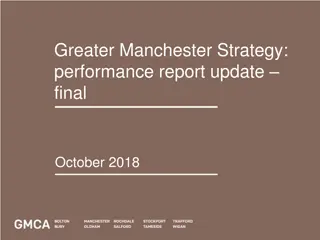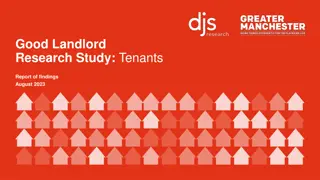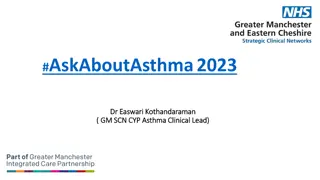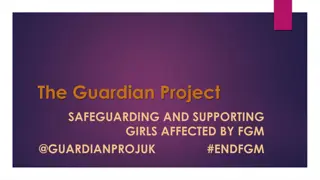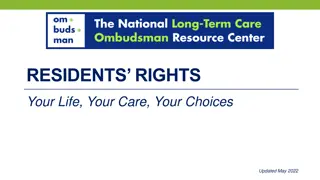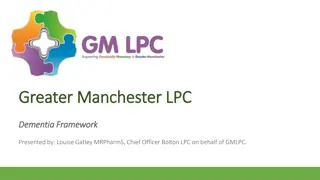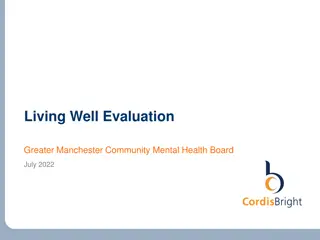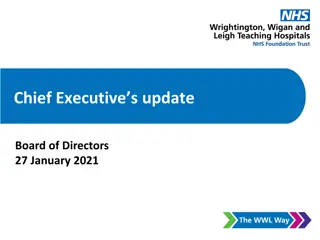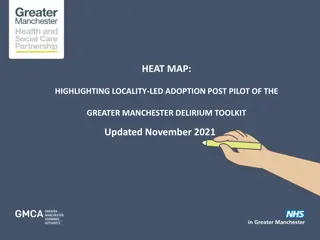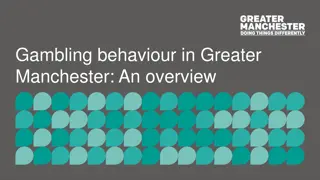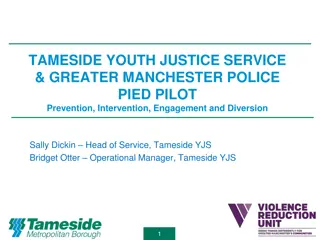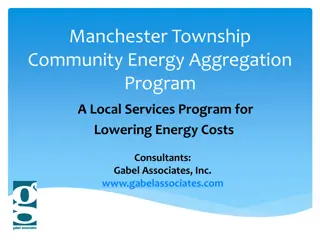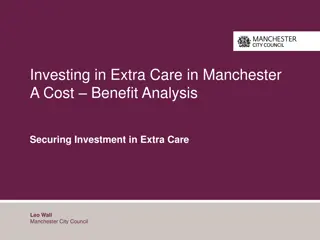Greater Manchester Residents Survey Analysis Overview
This report summarizes the findings of a quantitative survey conducted among Greater Manchester residents in December 2024. It includes insights on health and wellbeing, employment, local areas, cost of living, and digital inclusion, comparing data from previous surveys to provide a comprehensive view of residents' perceptions and behaviors.
Download Presentation

Please find below an Image/Link to download the presentation.
The content on the website is provided AS IS for your information and personal use only. It may not be sold, licensed, or shared on other websites without obtaining consent from the author.If you encounter any issues during the download, it is possible that the publisher has removed the file from their server.
You are allowed to download the files provided on this website for personal or commercial use, subject to the condition that they are used lawfully. All files are the property of their respective owners.
The content on the website is provided AS IS for your information and personal use only. It may not be sold, licensed, or shared on other websites without obtaining consent from the author.
E N D
Presentation Transcript
Greater Manchester Residents Survey Survey 16 (main report) February 2025 Fieldwork conducted 9th 23rd December 2024
Report contents 3 Introduction 7 Executive Summary 9 Health and wellbeing 24 Good work 38 Your local area 51 Cost of living 67 Digital inclusion 77 Appendix (further information on methodology, sample, key demographics and significance testing / statistical difference)
Introduction and methodology Background Methodology Report contents and guidance page 4 page 5 page 6
Background This report presents summary findings for a quantitative survey carried out between 9th and the 23rd December 2024, with a representative sample of 1,523 residents from across all ten Greater Manchester local authority areas. The report is divided into themed sections, providing an overview into respondents feelings and behaviours around personal health and wellbeing, good work, local area, cost of living and digital access. Data from December 2024 (survey 16) is presented alongside that from similar Greater Manchester resident surveys undertaken in October 2024 (survey 15) and August 2024 (survey 14). The following approaches have been used, identified as most appropriate for the datasets in each theme: health and wellbeing data from individual surveys is shown separately good work data from individual surveys is shown separately local area data from individual surveys is shown separately, except when commenting on trends for specific sub-groups or districts cost of living data from individual surveys is shown separately digital inclusion merged data for surveys 14, 15 and 16 is used, drawing on face-to-face responses only To provide a national comparison, where available, Greater Manchester findings are presented alongside the most recent benchmarking data from relevant national surveys for example, published figures from the Office for National Statistics (ONS) and the Department for Culture Media and Sport (DCMS). These surveys are intended to provide regular ongoing insights for Greater Manchester organisations and partners to help inform how and where to target support, communications / engagement activities and resources to improve the lives of Greater Manchester residents. 4
Methodology Between February 2022 and December 2024, BMG Research has undertaken sixteen surveys, each comprising circa 1,500 residents from across Greater Manchester. In surveys 1 to 11 the sample was comprised of approximately 750 online panel respondents, 250 telephone respondents, and 500 online riversampled respondents (those who responded to adverts, offers and invitations to take part in the surveys). From survey 12 (May 2024) onwards the methodology was revised, to now include around: 750 online panel respondents 500 online rapid respondents (see Appendix for more details), and 250 face-to-face respondents This mix of online and face-to-face surveying was agreed so that the most representative and robust sample of Greater Manchester residents can be regularly sourced within available time and budget. One of the main reasons the face-to-face element is included is so that those without internet access can take part in the survey. It has replaced the previous telephone approach because analysis suggests those who are truly digitally excluded are less likely to be able to take part by phone.* This new methodology will remain consistent for the duration of 2024/25. With five waves of face-to-face methodology now, it is apparent that the change in methodology has not had a negligible impact on results. See Appendix for more details. Each survey is designed to take 15 minutes on average for respondents to complete; however, due to the emotive nature of some topics covered, face-to-face interviews tend to take longer than this. Quotas are set to ensure the sample broadly reflects the profile of Greater Manchester s population by gender, age, ethnicity and disability, with further consideration of wider protected and key characteristics. Weights have been applied to the data gathered to ensure the sample matches the population profile by age, gender, ethnicity, disability and locality, and to ensure consistency between individual surveys. *When reviewing digital inclusion findings in this report, readers should be aware that some modal impacts do exist between telephone and face-to-face approaches because of the way participants are recruited. See relevant section of this report for more details on the rationale for changes in methodology for 2024/25 waves of the survey. 5
Report contents and guidance Identifying significant differences / change Where relevant, differences in findings for specific demographic and other population characteristics compared to the Greater Manchester average are reported. These differences are only highlighted where they are significantly different statistically (at the 95% level of confidence) compared with the total figures (i.e. the Greater Manchester average). Significant differences are shown in charts and tables with the use of up and down arrows. Further detail on significance testing can be found in the Appendix of this report. Sample sizes On some questions, responses have been filtered only to include respondents to whom the question is relevant (e.g. those in work, or with children), and so bases are lower than the full sample of 1,523 respondents in some instances. Where this is the case, this has been noted in the footnotes of each slide, along with the unweighted base sizes. Language - inequalities It should be noted that this report uses the term from within racially minoritised communities to refer to people and communities experiencing racial inequality (the term recognises that individuals have been minoritised through social processes rather than just existing as distinct minorities, although it is important to acknowledge the negative consequence of grouping all minoritised individuals together under one term, as there are significant differences both between and within these groups. Fromwithin has been added to recognise that not all in these communities will identify as minoritised). Due to limitations of sample size, we are generally unable to report findings from individual surveys for specific ethnic groups. However, where data is merged from multiple surveys over several months, the larger overall sample size allows us to look at smaller demographic groups in more detail. Any such differences are included throughout this report. 6
Executive Summary Health and Wellbeing Good Work Your local area Cost of living Two thirds (67%) of respondents are feeling satisfied with their lives overall, and that things they do in their lives are worthwhile. This is a relatively high benchmark compared to what we typically see in the survey, continuing a positive trend from October. You can find out more here. Three quarters (76%) of respondents are satisfied with their local area as a place to live, including 25% very satisfied (which is back in line with August 2024 following a slight drop in October 2024). Given that new DCMS benchmarking data suggests 74% of people across England are satisfied with their local area as a place to live, GM results can be seen in a broadly positive light. You can find out more here. 3 in 10 (29%) of GM respondents have borrowed more money or used more credit in the past month than was the case a year ago. Encouragingly, this is at least significantly lower than the proportions reporting this in Autumn 2023. Concurrently, more respondents (48%) feel like they may be able to save money in the coming twelve months. You can find out more here. Taken together with fieldwork in October, the latest figures suggest overall job satisfaction is a little lower than twelve months ago (Feb 2024). New insights show that a high percentage of respondents are working beyond their contracted hours (68%) and experiencing high levels of stress/pressure - (76%) of respondents in their job at least some of the time . You can find out more here and here. Levels of hopefulness about the future (79% hopeful) compare favourably to the latest figures being seen by the ONS across GB as a whole (69%). Sentiments about fair treatment by society are more in line with GB figures (though no worse when comparing latest respective fieldwork). You can find out more here. Less positively, the proportion of GM respondents finding it difficult to afford their energy costs (46%) remains significantly higher than the 32% GB benchmark. You can find out more here. 8% of GM respondents reported feeling lonely often or always , while approaching three in ten (28%) reported feeling lonely at least some of the time . These figures are broadly comparable with available GB benchmarks. You can find out more here. More positively, slightly fewer feel they might lose their job in the next year (14%, was 16% twelve months ago). Results also provide a sense that slightly more respondents are benefiting from flexibilities in their job (start and finish times; varying hours; taking an hour or two off for personal or family matters). You can find out more here and here. Though mortgage payers are still more likely than renters to be able to afford payments, 43% now say they are finding this difficult - the highest proportion recorded since residents survey tracking of this question was introduced in November 2022. You can find out more here. 8
Health and wellbeing Context Health and wellbeing key findings Health and wellbeing detailed findings page 10 pages 11-12 pages 13-23
Health and wellbeing context The Greater Manchester Residents' Survey investigates the four measures of personal wellbeing commonly asked in national surveys: life satisfaction anxiety happiness, and feelings that things done in life are worthwhile. Some of the health and wellbeing questions asked in the survey make up a core set of questions that we ve tracked for over a year and will continue tracking in future surveys. The wellbeing questions used are replicated from the Annual Population Survey. These are nationally recognised metrics, used in their current form since 2011. We also ask questions around people s abilities to manage their own health. This allows us to calculate and track changes over time in an overall Health Confidence Score for Greater Manchester. Questions are modelled on a published BMJ approach. For the fourth time, this survey also includes additional measures of wellbeing, around hope for the future and fairness of treatment by society. These questions mirror those from ONS UK Measures of National Well-being, allowing for comparison of Greater Manchester and national results.
Health and wellbeing key findings (1 of 2) SELF-REPORTED WELLBEING (CONTINUED TRACKING): Two-thirds (67%) of GM respondents record high life satisfaction, which is in line with previous waves, though a relatively high benchmark. This wave recorded the highest level of veryhigh life satisfaction so far at 22% of respondents, an increase since both October (20%) and August (18%) 2024. Similarly, the percentage of respondents who say things they do in their life are very worthwhile (score 9-10) has continued to increase compared to the last two waves, now at 28%, which is a joint-high figure from the past year. Just less than two-thirds (64%) report being happy with their lives, an increase from October (61%) and August (62%) 2024. While the picture looks positive in relation to satisfaction , worthwhile and happiness wellbeing strands, levels of anxiety nonetheless remain fairly constant in comparison to previous waves, with 54% of respondents reporting high or medium levels of anxiety. As we ve seen in previous waves, those with a disability are more likely to report low life satisfaction, high levels of anxiety, that things they do in their life are not at all worthwhile, and that not did feel at all happy yesterday. HOPE AND FAIRNESS (NEWLY INTRODUCED MEASURES SINCE S13) In December, 4 in 5 (79%) GM respondents reported high levels of hopefulness about their future, which is higher than the GB average of 69% - continuing the same trend seen in previous waves. Over the same period, 15% feel they are treated unfairly by society which has fallen since October (17%) and a positive feature of the latest data (in the sense that GM figures are now in line with GB average for the first time since this measure was introduced). Unsurprisingly, respondents with low levels of life satisfaction and low feelings that their life is worthwhile are more likely to feel low hopefulness and that society treats them unfairly. GB benchmarking figures taken from the UK Measures of National Well-being - Office for National Statistics (ons.gov.uk). This figure was published 20 December 2024 and relates to fieldwork undertaken on behalf of ONS between 6 November to 1 December 2024.
Health and wellbeing key findings (2 of 2) HEALTH CONFIDENCE (CONTINUED TRACKING) Greater Manchester recorded a health confidence score (HCS) of 72.1 this survey, which represents a continued moderate level of health confidence among Greater Manchester respondents. This means that the score has remained relatively stable across all of 2024, never lower than 71.4 (Feb and August) and never higher than 72.1 (May and December). This continuity in the overall HCS is reflected in the underlying tracking measures as follows (where there have been some small-level shifts, generally of a positive nature, but no significant change) Appendix provides the detail 92% say that they are involved in decisions about themselves (in line with October 2024) Those agreeing that they can get the right help if they need it has increased to 77% compared to 75% in the previous wave 85% agree that they can look after their health reporting an increase of 1pp since October 4 in 5 (79%) agree that they know enough about their health, just 1pp higher than October 2024 Disabled respondents recorded a HCS of 64.3, which is the same score for disabled respondents in the previous wave, again representing a moderate level of health confidence. Disabled respondents note an increase in agreement that they can get the right help if they need it (+1.5), but a decrease in the involvement of decisions about themselves (-2.0) since the previous wave. This wave we have explored health confidence among respondents from racially minoritised communities. This group reports a HCS of 70.7, which is lower than the average Greater Manchester score of 72.1. A similar picture emerges when looking back over the last three survey waves. *We have also looked at the HCS of racially minoritised communities across the previous three waves (August, October & December 2024), due to the increased robustness of the sample size. This HCS is reported at 70.4 out of 100. Knowledge and shareddecision report the biggest gaps between racially minoritised respondents and the rest of Greater Manchester.
Life satisfaction remains high this wave among Greater Manchester residents, with respondents with very high satisfaction reaching an all-time high of 22% (up 2% from October 2024). How satisfied are you with your life nowadays? 22% 20% 20% 20% 20% 19% 18% 18% 18% 18% 18% 18% 16% Very high (9-10) Two-thirds (67%) of GM respondents record high or very high life satisfaction High (7-8) 47% 46% 46% 46% 45% 45% 44% 44% 43% 43% 43% 43% 42% 26% Medium (5-6) 24% 23% 23% 23% 23% 23% 22% 22% 22% 21% 21% 20% Low (0-4) 16% 16% 15% 15% 15% 14% 14% 14% 13% 13% 13% 12% 12% Nov '22 (S4) Dec '22 (S5) Mar '23 (S6) May '23 (S7) July '23 (S8) Sept '23 (S9) Nov '23 (S10) Feb '24 (S11) May '24 (S12) July '24 (S13) Aug '24 (S14) Oct '24 (S15) Dec '24 (S16) A1. Where 0 is not at all and 10 is completely Unweighted base: Greater Manchester Residents Survey 4: 1636; Survey 5: 1470; Survey 6: 1767, Survey 7: 1488, Survey 8: 1612, Survey 9: 1560, Survey 10: 1546, Survey 11: 1460, Survey 12: 1551, Survey 13: 1540, Survey 14: 1482, Survey 15: 1517; Survey 16: 1523 13
Respondents who say things they do in their life are very worthwhile (score 9-10) have continued to increase since the last two waves, now at a joint-high 28%. However, those with disabilities continue to be significantly less positive that the things they do in their life are worthwhile. To what extent are the things you do in your life worthwhile? % who felt that the things they do in their life are not at all worthwhile compared to GM average (12%)*: Demographics: Those who have a disability (22%), including mental ill health (31%), a sensory disability (25%), learning disability(24%) or mobility disability (23%) Those not heterosexual (19%) Individual and/or family circumstance: Those who have been out of work for 6 months or more (29%), out of work for more than 6 months (24%) and studying at school/college (25%) Those with a household income below 10.4k (23%) 28% 28% 26% 25% 25% 24% 23% 23% 23% Very high (9-10) 41% 41% 41% 41% 40% 40% 39% 38% 38% High (7-8) 24% 23% 23% 22% 22% 22% 22% 21% 21% Medium (5-6) 15% 14% 14% 13% 13% 12% 12% 12% 11% Low (0-4) * Subgroup analysis uses merged data from S14-16 May '23 (S7) July '23 (S8) November '23 (S10) February '24 (S11) May '24 (S12) July '24 (S13) August '24 (S14) October '24 (S15) December '24 (S16) 14 Q10. Overall, to what extent do you feel that the things you do in your life are worthwhile, on a scale of 0 to 10, where 0 is not at all and 10 is completely ? / Unweighted base: (All respondents) S7, 1488; S8, 1612; S9, 1560; S10, 1546; S11, 1460; S12, 1551; S13, 1540; S14, 1482; S15, 1517; S16, 1523. Thresholds are applied to responses to convert the 11-point scale into the categories shown. Unweighted base: S14-16 = 4522 (All respondents).
One-quarter (26%) of respondents say they feel a very high level of happiness the highest recorded figure so far. However, similarly to thinking things in their life are worthwhile, those with a disability are significantly more likely to not feel at all happy yesterday (score 0-4). How happy did you feel yesterday? % who did not feel at all happy yesterday, compared to the GM average (15%)*: Demographics: Those who have a disability (27%), including those with mental ill health (39%), a mobility disability (29%) or sensory disability (26%) Those with a mixed ethnicity (25%) Those not heterosexual (20%) Individual and/or family circumstance: Those not in work due to ill health or disability (45%) Those out of work for 6 months or less (31%) 26% 24% 23% 23% 22% 22% 22% 21% 20% Very high (9-10) High (7-8) 40% 38% 38% 38% 38% 38% 37% 36% 35% 26% 25% 25% 24% 24% 23% 23% 23% 22% Medium (5-6) 18% 17% 17% 16% 16% 15% 15% 14% 14% Low (0-4) * Subgroup analysis uses merged data from S14-16 May '23 (S7) July '23 (S8) November '23 February '24 (S10) May '24 (S12) July '24 (S13) August '24 (S14) October '24 (S15) December '24 (S16) (S11) 15 Q11. Overall, how happy did you feel yesterday, on a scale of 0 to 10, where 0 is not at all and 10 is completely ? S7, 1488; S8, 1612; S9, 1560; S10, 1546; S11, 1460; S12, 1551; S13, 1540; S14, 1482; S15, 1517; S16, 1523. Thresholds are applied to responses to convert the 11-point scale into the categories shown. Unweighted base: Greater Manchester Residents Survey 14-16: 4522 (All respondents)
Despite positive life satisfaction, levels of high anxiety also remain high in comparison to medium, low, and very low anxiety. How anxious did you feel yesterday? 43% 42% 42% 41% 41% 41% 40% 38% 38% 38% 37% 37% 36% High (6-10) 19% 18% 18% 18% 18% 18% 18% 18% 17% 17% 17% 17% 17% Medium (4-5) 21% 20% 20% 19% 19% 19% 19% 18% 18% 18% 18% 17% 16% Low (2-3) 27% 26% 25% 25% 25% 25% 24% 24% 24% 23% 23% 22% 20% Very low (0-1) Nov '22 (S4) Dec '22 (S5) Mar '23 (S6) May '23 (S7) July '23 (S8) Sept '23 (S9) Nov '23 (S10) Feb '24 (S11) May '24 (S12) July '24 (S13) Aug '24 (S14) Oct '24 (S15) Dec '24 (S16) A2. Where 0 is not at all and 10 is completely Unweighted base: Greater Manchester Residents Survey 4, 1636; Survey 5: 1470, Survey 6: 1767, Survey 7: 1488, Survey 8: 1612, Survey 9: 1560, Survey 10: 1546, Survey 11: 1460, Survey 12: 1551, Survey 13: 1540, Survey 14: 1482, Survey 15: 1517; Survey 16: 1523 16
When looking at sub-groups, respondents with a disability are more likely to have low levels of life satisfaction and high levels of anxiety. % with higher levels of low life satisfaction compared to GM average (13%)*: % who felt highly anxious compared to GM average (38%) is higher among*: Demographics: Those with a disability (25%), including those with mental ill health (35%), a mobility disability (27%), a sensory disability (27%), learning disability (21%) or other disability (21%) Those with no religion (15%) Those who are not heterosexual (17%), particularly those bisexual (18%) Demographics: Those with a disability (53%) including those with mental ill health (65%) or other disability (53%). Those who are not heterosexual (53%), particularly those bisexual (47%) Those aged 18-24 (48%) or 45-54 (47%) Individual and/or family circumstance: Those who find it difficult to afford their energy bills (67%) Those with a household income of 15.6k to 26k (63%) Those who do not have children in the house (63%) Those who disagree that they know enough about their health (58%) Those who have borrowed money/used more credit in the past month (58%) and find themselves financially vulnerable (49%) Those who have been out of work for more than 6 months (57%), those not in work due to ill health/disability (54%), and those out of work for 6 months or less (50%) Those who are likely to lose their job in the next 12 months (52%) Those who disagree that people look out for each other in their community (51%) and those dissatisfied with their local area (50%) Renters (50%) Individual and/or family circumstance: Those who do not feel they can look after their own health (43%) or know enough about their own health (37%) Those not in work due to ill health or disability (41%), have been out of work for 6 months or less (37%), or have been out of work for more than 6 months (30%) Those dissatisfied with their local area (32%) or would not recommend their local area (28%) Those who have been treated unfairly by society (32%) Those who are dissatisfied with their job (31%), pay (22%) or work hours (22%) Those who feel lonely at least some of the time (28%) Those with a household income below 10.4k (27%) * Subgroup analysis uses merged data from S14, 15 and 16 combined. Italics denotes greater prominence / newly featuring in latest analysis compared to previous wave A1. Where 0 is not at all and 10 is completely A2. Where 0 is not at all and 10 is completely Unweighted base: Greater Manchester Residents Surveys 14-16, 4522
Hopefulness about the future continues to be higher in GM than GB (79% cf. 69%), though feeling like they are treated unfairly by society is equal across GM and GB respondents (both 15%). How hopeful do you feel about your future? How fairly or unfairly do you feel you are treated by society? 20% 22% 26% Very fairly Hopeful 69% Somewhat fairly 76% 38% 35% 79% 34% Neither fairly nor unfairly Neither hopeful nor unhopeful Somewhat unfairly 23% 23% 23% 14% Unhopeful Very unfairly 11% 10% 13% 12% 12% 18% 13% 11% 3% 4% 4% 4% 3% 2% July - October '24 (S13+14+15) December '24 (S16) GB July - Oct '24 (S13 +S14+S15) Dec '24 (S16) GB Benchmarking Benchmarking* Significantly higher/lower than GB benchmark 18 A3. Overall, how hopeful do you feel about your future, where 0 is 'not at all hopeful' and 10 is 'completely hopeful ? A4. How fairly or unfairly do you feel you are treated by society? Base: Survey 16, 1523. GB benchmarking taken from UK measures of wellbeing (fieldwork period 6 November 1 December 2024) *Figure is 66% in national figures, but this has been rebased for reporting purposes here
Respondents with low levels of life satisfaction and low feelings that things they do in their life are worthwhile are, perhaps unsurprisingly, significantly more likely to feel low hopefulness and that society treats them unfairly. Those who do not feel they can look after their own health also continue to be less positive about these two metrics. % with higher levels of low hopefulness compared to GM average (12%)*: % who felt society treats them unfairly compared to GM average (17%) * is higher among: Demographics: Those with a disability (27%) including mental ill health (36%), or a sensory disability (30%), or a mobility disability (30%) Those who are bisexual (20%) Those with no religion (15%) Demographics: Those with a disability (29%), including those with mental ill health (34%), learning disability (33%), mobility disability (31%) or a sensory disability (30%) Gay men (29%) Gay women or lesbians (27%) Individual and/or family circumstance: Those who do not feel they can look after their own health (52%) or know enough about their own health (36%) Those not in work due to ill health or disability (40%) Those who have been out of work for 6 months or more (32%), and those who have been out of work for less than 6 months (24%) Those who are not satisfied with their job (27%) or with their work hours (22%) Those who would not recommend their local area as a place to live (27%) Those who rent from a local authority/council (25%) Those who are lonely at least some of the time (24%) Those with a physical or mental condition that has lasted longer than 12 months (22%) Those with a household income of less than 10.4k (22%) Individual and/or family circumstance: Those that think the things they do in their life are not worthwhile (37%) Those who find it difficult in affording rent (29%) Those who do not feel they can look after their own health (53%) or know enough about their own health (44%) Those with very low levels of hopefulness (50%), low levels of life satisfaction (41%) and low levels of happiness (38%) Those dissatisfied with their local area (41%) Those not in work due to ill health or disability (35%) Those who work as sole traders (30%) Those who are not satisfied with their pay (30%), or with their job (25%). Those who are financially vulnerable (28%) Those who have been out of work for 6 months or more (25%) * Subgroup analysis uses merged data from S14, S15 and S16 combined. Italics denotes greater prominence / newly featuring in latest analysis compared to previous wave A3. Overall, how hopeful do you feel about your future, where 0 is 'not at all hopeful' and 10 is 'completely hopeful ? A4. How fairly or unfairly do you feel you are treated by society? Unweighted base: Greater Manchester Residents Surveys 14-16, 4510-4522
The overall Health Confidence Score (HCS) has remained consistent with October 2024, with just a 0.1 change. However, each metric within HCS has witnessed a small degree of change, with more respondents positive about access and self-management. Longer-term trends are shown in the Appendix Access 67.6 +1 (since October) I can get the right help if I need it Knowledge 67.6 -0.5 (since October) I know enough about my health Self-management 72.1 +0.7 (since October) I can look after my health Shared decision 80.9 -1 (since October) I am involved in decisions about me An overall health confidence score is calculated based on responses to four questions, each covering one of four dimensions access, knowledge, self-management, shared decisions Wave HCS 7 70.5 On a 0-100 scale, these thresholds are given the following interpretations: 8 71.8 Overall Greater Manchester health confidence score (out of 100) 72.1 This is +0.1 points higher than in October 2024 9 71.5 10 70 High 80-100 11 71.4 Moderate 60-79 12 72.1 Low 40-59 13 71.6 14 71.4 Very low 0-39 15 72.0 16 72.1 S14. To what extent do you agree or disagree with the following statements? Unweighted base: All respondents Survey 16, 1523 (All responses) 20
Among disabled respondents, the Health Confidence Score (HCS) remains 64.3 out of 100, as seen in October 2024. However, similarly to with GM residents, there have been fluctuations within each HCS metric. Access 60.0 +1.5 (vs. GM) I can get the right help if I need it Knowledge 62.4 +0.1 (vs. GM) I know enough about my health Self-management 59.4 +0.4 (vs. GM) I can look after my health Shared decision 75.5 -2.0 (vs. GM) I am involved in decisions about me An overall health confidence score is calculated based on responses to four questions, each covering one of four dimensions access, knowledge, self-management, shared decisions Wave HCS 7 60.5 On a 0-100 scale, these thresholds are given the following interpretations: 8 63.1 Disabled respondents' health confidence score (out of 100) 64.3 This is +/-0 points lower than in the overall GM score 9 62.6 10 61.7 High 80-100 11 61.5 Moderate 60-79 12 64.7 13 64.0 Low 40-59 14 60.8 Very low 0-39 15 64.3 16 64.3 S14. To what extent do you agree or disagree with the following statements? Unweighted base: All disabled respondents Survey 16, 435 (Valid responses) 21
The overall health confidence score continues to remain lower for disabled respondents than for the general population, with gaps also remaining constant compared to October 2024. Overall Health Confidence Score Disabled Overall 72.1 70.5 60.5 64.3 May '23 (S7) July '23 (S8) Sep '23 (S9) Nov '23 (S10) Feb '24 (S11) May '24 (S12) July '24 (S13) Aug '24 (S14) Oct '24 (S15) December '24 (S16) Self-Management Knowledge 72.1 70.4 67.6 66.8 56.8 60.2 62.4 59.4 May '23 July '23 Sep '23 Nov '23 Feb '24 May '24 July '24 Aug '24 Oct '24 Dec '24 (S7) (S8) (S9) (S10) (S11) May '23 July '23 Sep '23 Nov '23 Feb '24 May '24 July '24 Aug '24 Oct '24 Dec '24 (S7) (S8) (S9) (S10) (S11) (S12) (S13) (S14) (S15) (S16) (S12) (S13) (S14) (S15) (S16) Shared Decisions Access 80.9 67.6 80.6 73.0 64.0 75.5 52.1 60.0 May '23 July '23 Sep '23 Nov '23 Feb '24 May '24 July '24 Aug '24 Oct '24 Dec '24 (S7) (S8) (S9) (S10) (S11) May '23 July '23 Sep '23 Nov '23 Feb '24 May '24 July '24 Aug '24 Oct '24 Dec '24 (S7) (S8) (S9) (S10) (S11) (S12) (S13) (S14) (S15) (S16) (S12) (S13) (S14) (S15) (S16) S14. To what extent do you agree or disagree with the following statements? Unweighted base: Survey 16, 1523 (All responses); 435 (Disabled respondents) 22
This wave we have also looked specifically at respondents from within racially minoritised communities. These residents have a lower-than-average level of health confidence compared to respondents as a whole reported at 70.7 out of 100, lower than the overall GM score of 71.4. The Appendix includes equivalent analysis over the last three surveys Access 67.2 -0.4 (vs. GM) I can get the right help if I need it Knowledge 65.8 -1.8 (vs. GM) I know enough about my health Self-management 70.1 -2.0 (vs. GM) I can look after my health Shared decision 79.6 -1.3 (vs. GM) I am involved in decisions about me An overall health confidence score is calculated based on responses to four questions, each covering one of four dimensions access, knowledge, self-management, shared decisions On a 0-100 scale, these thresholds are given the following interpretations: Racially minoritised communities health confidence score (out of 100) 70.7 This is -1.4 points higher than in the overall GM score High 80-100 Moderate 60-79 Low 40-59 Very low 0-39 S14. To what extent do you agree or disagree with the following statements? Unweighted base: Racially minoritised communities S16, 244 (Valid responses) 23
Good Work Overview and context Good work key findings Good work detailed findings page 25 page 26-27 pages 28-37
Good work context The GM Residents' Survey includes a number of questions designed to explore residents' experiences of their job and working environment, including the degree of influence and flexibility they have over their work, job satisfaction, and job security. Following a review of the current questions in October 2024, the Good Work section was revised to include additional questions exploring employment situation, job stress, and opportunities for personal development among other areas. This section shows data from Survey 16 (December 2023), Survey 15 (October 2024) and Survey 11 (February 2024). The results highlight potential trends and indicators which individual localities will, in due course, be able to explore in greater detail. 850 respondents within the overall residents survey sample are employed, over half (56%) of the total sample of 1,523. Most employed respondents in this survey are employed in permanent full-time positions (58%). 18% are permanent part-time positions. Of the remaining respondents, 9% are self-employed sole traders, and 7% are on a fixed term contract.
Good work key findings (1 of 2) JOB SATISFACTION Satisfaction with jobs, pay and working hours remain broadly consistent in Dec 2024 with Oct 2024: 66% are satisfied with their jobs (cf. 64%), 49% with their pay (cf. 50%), 69% with their working hours (cf. 69%). This means that key findings reported from October fieldwork can be reiterated here: overall job satisfaction appears to have decreased since February 2024; satisfaction with pay is higher; while satisfaction with hours has remained broadly similar On the topic of pay, two thirds (67%) say that their pay fairly reflects their work at least to some extent, which has remained stable since last wave. 12%, however, do say this is not the case at all On the topic of hours, despite 69% reporting satisfaction with their hours, a very similar proportion (68%) say that their job sees them work beyond their contracted hours at least sometimes. This figure has significantly increased since the previous wave. JOB SECURITY About 1 in 7 employed respondents (14%) have concerns around job security, saying they feel there is some likelihood they will lose their job over the next year. This figure is a significantly lower figure than February (19%), though things have remained stable since October. Latest figures are significantly higher for those with a disability (23%), those from within racially minoritised communities (20%) and those with caring responsibilities (24%) FLEXIBILITY Experiences relating to job flexibility have remained stable with October 2024. 1 in 3 (34%) say it is difficult to arrange an hour or two off during work hours for personal or family matters (the same as in October 2024). This does, however, compare favourably with figures from February 2024 (when 41% said this was difficult). A slightly lower proportion than in October 2024 say that it is difficult to ask to vary their working hours (42% in latest figures; 45% in October 2024). This is encouraging given than 49% indicated this was difficult in February 2024. Also encouragingly, there has been a reduction in proportions feeling they have a degree of influence over when they start or finish work.
Good work key findings (2 of 2) INFLUENCE People's ability to influence their work has largely remained in line with figures both from February 2024 and October 2024. 14% say they do not have much influence over deciding what task to do next (cf. 16% in Oct 2024; 14% in Feb 2024); 12% say they do not have much influence on deciding how to do the task (cf. 13% in Oct 2024; 13% in Feb 2024); and 17% say they have little influence over the pace of their work (cf. 20% in Oct 2024; 18% in Feb 2024). OVERTIME AND WELLBEING (questions first introduced in October) Results look different to October in terms of people working extra hours: the proportions of respondents saying they sometimes have to work beyond their contracted hours has increased significantly from 62% in Oct 2024 to 68% in Dec 2024. 9% say they never have to do this, but 11% say this is always the case. Three quarters (76%) say their job frequently involves high levels of stress or pressure at least sometimes (equal to October s figures, 76%). 13% say this is always the case (again, in line with October s figures, 13%). PERSONAL DEVELOPMENT (questions first introduced in October) Three quarters (74%) of employed respondents say they have been given a professional development or training opportunity in the last 12 month (34% were given 1-2 opportunities, while 7% were given more than 6 opportunities). Conversely, one in five (22%) reported no professional development or training opportunities. These figures are all in line with October 2024 figures, where 73% had been given at least one opportunity and 22% received none. 4 in 5 (84%) say their job requires them to learn new things at least sometimes. Three quarters (74%) agree their job makes good use of their skills and abilities (similar to October 2024) though a smaller proportion (9%) disagree in this survey wave compared to October 2024 (13%).
Satisfaction with jobs, pay and working hours remain broadly consistent in Dec 2024 with Oct 2024. Taken together with fieldwork in October, the latest figures suggest overall job satisfaction is a little lower than twelve months ago (Feb 2024), though satisfaction with pay is a little higher Job satisfaction I am satisfied with my job I am satisfied with my pay I am satisfied with my hours 13% 14% 15% 20% 22% 22% 23% 24% 24% Strongly agree 46% 49% 50% 33% 66% Agree 34% 36% 66% 64% 69% 68% 69% 43% 43% 44% 50% 45% 44% Neither agree nor disagree 20% 24% 21% Disagree 19% 22% 16% 16% 17% 22% 23% 20% 19% Strongly disagree 11% 10% 10% 4% 9% 10% 9% 9% 8% 4% 9% 5% 5% 4% 3% Feb 2024 (S11) Oct 2024 (S15) Dec 2024 (S16) Don't know / Prefer not to say Feb 2024 (S11) Oct 2024 (S15) Dec 2024 (S16) Feb 2024 (S11) Oct 2024 (S15) Dec 2024 (S16) Significantly higher/lower than S15 GW8. How much do you agree or disagree with the following statements? Base: All employed residents; 1004 (S11), 878 (S15), 896 (S16) 28
On the topic of pay, two thirds (67%) say that their pay fairly reflects their work at least to some extent, which has remained stable since last wave. 12% say this is not the case at all To what extent do you believe that your pay fairly reflects the work that you do? Respondents significantly more likely to believe that their pay reflects the work they do (to at least a considerable extent) in comparison to the 35% of the GM average: 12% (+1pp) 23% (+/-0pp) Demographics: Those who are Black or Black British (50%) Those who are 65+ (48%) Those who are Christian (42%) Those who are male (41%) Completely 67% (-2pp) To a considerable extent To some extent To a minor extent 32% (-3pp) Not at all Individual and/or family circumstance: Those who have very high life satisfaction (59%) Those with a household income of 78,000 and above (57%) Those with high hopefulness (51%) Those with children in the house aged 16-17 (46%) Those who say they are treated fairly by society (44%) Don't know 19% (+2pp) 12% (-1pp) 1% GW2_6. To what extent do you believe that your pay fairly reflects the work that you do? Base: Those who are employed S15 (751), S16 (774)
On the topic of hours, despite 69% reporting satisfaction with their hours, a very similar proportion (68%) say that their job sees them work beyond their contracted hours at least sometimes. This has significantly increased when compared with the previous wave. How often do you work beyond your contracted hours? Respondents most likely to at least sometimes work beyond their contracted hours compared to 68% of the GM average: 9% (-4pp) Those who have a mobility disability (79%) Those who find it difficult to afford their mortgage (73%) Those who are lonely at least some of the time (69%) Those who are Christian (68%) 22% (-2pp) Never Rarely Significantly higher/lower than S15 37% (+2pp) Sometimes Often 68% (+6pp) Always 20% (+4pp) Don't know 11% (+/-0pp) 1% GW2_3. How frequently does your job involve high levels of stress of pressure? Base: Those who are employed S15 (751), S16 (774). GW2_5. How often do you work beyond your contracted hours? Base: All online respondents who work S15(684), S16 (685)
Three quarters (76%) say that their job involves high levels of stress or pressure at least sometimes. This is consistent overall with the finding from October 2024 (when this question was first asked), though there has been a shift towards respondents saying this occurs often rather than sometimes How frequently does your job involve high levels of stress or pressure? 4% Respondents most likely to have a job that frequently involves high levels of stress or pressure at least sometimes, compared to 76% of the GM average: 20% (+1pp) Those who disagree about knowing enough about own health (88%) Those who have difficulty affording their rent (83%) Those with a household income of 36,400 to 51,999 per year (82%) Those with high levels of anxiety (81%) Those aged 16-64 (76%) 38% (-6pp) 76% (+/-0pp) Significantly higher/lower than S15 25% (+6pp) 13% GW2_3. How frequently does your job involve high levels of stress of pressure? Base: Those who are employed S15 (751), S16 (774).
On the topic of job security, 14% of respondents think that they are likely to lose their job in the next 12 months. Positively, this is a significantly lower figure than February (19%), though things have remained stable since October. This sense of insecurity is higher amongst those experiencing some aspect of financial difficulties, those who are self-employed and disabled respondents How likely do you think you are to lose your job and become unemployed in the next 12 months? Respondents likely to lose their job in the next 12 months in comparison to the GM average (14%): Very unlikely Demographics: Those who identify at trans (48%) Those with a learning disability (43%) Those who are Pakistani (27%) Those aged 16-24 (25%) Individual and/or family circumstance: Those who have a condition that reduces their ability to do activities a lot (42%) Those with a household income up to 10,399 a year (32%) Those who are self-employed sole trader (29%) Those with very low levels of hopefulness (28%) Those with low levels of happiness (21%) 41% 42% 46% Somewhat unlikely Neither likely nor unlikely 19% 24% 21% Somewhat likely 16% 17% Very likely 15% 14% 19% 9% 14% 14% 10% Don't know 5% 5% 3% February (S11) October (S15) December (S16) Significantly higher/lower than S15 GW6ai. How likely do you think you are to lose your job and become unemployed in the next twelve months? Base: S15 (839), S16 (850). All employed respondents who are in a paid job (not self-employed)) 32
Experiences with job flexibility have remained relatively stable since October 2024, though when comparing to February 2024, there is a significant improvement. 1 in 3 (34%) say it is difficult to arrange an hour or two off during work hours for personal or family matters, compared to 41% in February. 42% say that it is difficult to ask to vary their working hours, which is an encouraging improvement compared February 2024 (49%). Flexible aspects of working Figures in brackets show change since Oct 24 (S15) 11% Strongly agree 15% (-1pp) Very difficult 19% (+3pp) 34% (+/-0pp) 42% (-3pp) Agree 23% (+/-0pp) (+2pp) Somewhat difficult 27% 27% (+1pp) (-2pp) Those in the public sector are significantly less likely to find it not difficult at all to ask to vary their working hours Neither agree nor disagree Not too difficult 36% (+5pp) 17% (+4pp) Disagree 36% Those earning below the Real Living Wage are significantly less likely to strongly disagree that they can decide their start and finish times at work Not at all difficult (+7pp) Strongly disagree 22% (+1pp) 28% (-5pp) 20% (-4pp) Don't know/Prefer not to say Don't know 15% (-7pp) Arranging to take an hour or two off during work hours to take care of personal or family matters Asking to vary your working hours I can decide the time I start and finish work Significantly higher/lower than S15 GW3. How difficult would you say the following aspects of work are? Arranging to take an hour or two off during work hours to take care of personal or family matters | Asking to vary your working hours Base: S15 (878), S16 (896) (All online respondents who are working). GW8. How much do you agree or disagree with the following statements? Base: S15 (878), S16 (896) (Rapid response panel respondents who are working) 33
Those reporting difficulty with job flexibility at a significantly higher rate include people in racially minoritised groups and those with a disability % who are significantly more likely to find it difficult to ask to vary their working hours compared to the merged S15-16 GM average (42%): % who are significantly more likely to find it difficult to take an hour or two off during work hours compared to the merged S15-16 GM average (34%): Demographics: Those who are shown discrimination almost all/ a lot of the time due to their sexual orientation (59%) Those who are shown discrimination almost all/ a lot of the time due to their ethnic background (54%) Those who have a learning disability (51%) Those who are Pakistani (50%) Those who identified as trans (48%) Those aged 16-24 (41%) Those who are Muslim (44%) Those whose first language is not English (43%) Demographics: Those who have a learning disability (57%) Those from minority ethnic groups (49%) Those who are 25-34 (49%) Individual or family circumstance: Those who are dissatisfied with their job (64%) Those with very low hopefulness (60%) Those with 4+ people in their household (56%) Those who feel low about their life being worthwhile (55%) Those who say they are treated unfairly in society (54%) Those likely to lose their job over the next 12 months (52%) Those who have high levels of anxiety (51%) Those who earn 36,400 to 51,999 per year (49%) Those in permanent full time employment (47%) Those who have children in their house (46%) Individual or family circumstance: Those who are dissatisfied with their job (54%) Those who are dissatisfied with their work hours (52%) Those who have high levels of stress/ pressure often or always at work (51%) Those who have very low hopefulness (50%) Those who earn up to 10,399 per year (49%) Those whose pay does not fairly reflect their work (48%) Those likely to lose their job over the next 12 months (47%) Those who have high levels of anxiety (44%) Subgroup analysis uses merged data from S15 and S16 GW3. How difficult would you say the following aspects of work are? Arranging to take an hour or two off during work hours to take care of personal or family matters | Asking to vary your working hours. Base: 1774, S15 (878), S16 (896) 34
There has been no significant change since October 2024 nor since February - in the proportion of employed respondents being unable to influence the pace of their work (17%) or choose the task they do next (14%). They are equally as likely to say that they do not have any influence on how to do the task (13%). How much influence do you have on ? Figures in brackets show change since Oct 24 (S15) A great deal 39% (-2pp) 46% (+2pp) 46% (+4pp) Those earning above the Real Living Wage are significantly more likely to agree they have at least a fair amount of influence on each of these tasks A fair amount Not much 42% (+4pp) 39% None at all 40% (-1pp) (-2pp) Don't know/Prefer not to say 17% (-3pp) 14% (-1pp) 14% (-2pp) 13% (+/-0pp) 12% (+/-0pp) 2% (-2pp) 10% (+/-0pp) (-1pp) 3% (-2pp) 2% Deciding what task to do next Deciding how to do the task The pace of your work Significantly higher/lower than S15 GW1. How much influence do you personally have on ? Base: S15 (878), S16 (896) (All online respondents who are working) 35
In terms of development and training opportunities, a fifth (22%) say they have not had any opportunities made available to them. A third (34%) say they have had at least 1-2 opportunities over the last year, which remains stable for all employed respondents compared to October 2024 How many professional development or training opportunities have been available to you in the past 12 months? 27% Those working in the private sector 22% (+/-0pp) None 18% (-1pp) 30%(-1pp) (-1pp) 34% 33% 1-2 opportunities (-3pp) 39%(+6pp) 23% (+1pp) 3-4 opportunities 26% (+3pp) 12% (-7pp) All employed respondents Full time permanent 10% (+4pp) 12% 5-6 opportunities (+6pp) 5%(-3pp) 12% Those working in the public sector 7%(-2pp) 6% (-4pp) Part time permanent More than 6 opportunities 9% (+2pp) 4%(+/-0pp) 4%(-1pp) 4%(+2pp) Can't remember Figures in brackets show change since Oct 2024 (S15) 1% (+/-0pp) 0%(-1pp) 1% (+/-0pp) Significantly higher/lower than all employed respondents Prefer not to say GW2_7.How many professional development or training opportunities have been available to you in the past 12 months? Base: All online respondents who are employed S15 (751), S16 (774). All in full time permanent employment S15 (549), S16 (552). All in part time permanent employment S15 (166), S16 (181).
74% agree that their job makes good use of their skills and abilities, with a smaller proportion disagreeing this wave compared to October 2024 (9% cf. 13%). 84% say they are required to learn new things for their job at least sometimes. Both these figures have remained stable since the previous wave To what extent do you agree or disagree that your job makes good use of your skills and abilities? Figures in brackets show change since Oct 24 (S15) How often does your job require you to learn new things? 13% (+/-0pp) Strongly agree 28% (+/-0pp) Always Agree 29% Often (-1pp) 74% Sometimes Neither agree nor disagree 84% (+/-0pp) (+1pp) Rarely 47% (+2pp) Disagree Never 42% (+1pp) Don't know Strongly disagree Don't know 16% (+2pp) 13% (-2pp) 3% (+2pp) 5% (-5pp) 4%(+1pp) GW2_2. To what extent do you agree or disagree with the following statement: My job makes good use of my skills and abilities. Base: All online respondents who are employed S15 (751), S16 (774). GW2_1. How often does your job require you to learn new things? Base: All online respondents who are employed S15 (751), S16 (774).
Your Local Area Local Area context Local Area key findings Local Area detailed findings page 39 pages 40-41 pages 42-50
Your local area context The survey continues to explore residents' experiences of their local area, along with their sense of community, local pride and belonging. The questions have been included to inform local monitoring and evaluation of programmes aiming to increase pride in place and life chances (including those funded through local growth funds such as the UK Shared Prosperity Fund). As questions on local area have been asked across multiple surveys, we have tracked data over time. We have also merged data where possible, meaning that the sample is larger and more robust and greater analysis of sub-groups is possible. Questions within this section use a merged sample from the results from surveys 13, 14 and 15. Benchmarks, where included, reflect most recent published national data from two sources: 1. The DCMS' Community Life Survey (covering October 2023 March 2024) this source references benchmarking figures for England only. 2. UK Measures of National Well-being (covering 6 November 2024 1 December 2024) this source references benchmarking figures for Great Britain. England benchmarking figures taken from the DCMS Community Life Survey. This report was published on 4 December 2024 and relates to fieldwork between October 2023 and March 2024. GB benchmarking figures taken from the UK Measures of National Well-being - Office for National Statistics (ons.gov.uk). This figure was published 20 December 2024 and relates to fieldwork undertaken on behalf of ONS between 6 November to 1 December 2024.
Your local area key findings (1 of 2) OVERALL SATISFACTION WITH LOCAL AREA Overall satisfaction with respondents local areas as a place to live has significantly increased to three-quarters (76%) since October 2024. Satisfaction in Greater Manchester is now higher than the England benchmark of 74% (noting that this most recent national benchmark is 2pp lower than the prior figure reported by DCMS). Respondents who recommend their local area as a place to live has also remained in line with previous surveys, at 4 in 5 (80%) compared to 78% last wave. This figures rises even higher among younger age groups, aged 16-24 (27%) and those with a disability (28%). SATISFACTION WITH TRANSPORT & TRAVEL OPTIONS Respondents continue to be the most satisfied with the general availability of public transport in their local area, with this at two-thirds (67%) of respondents. Satisfaction is then next highest for bus services, with 3 in 5 (59%) respondents reporting satisfaction, followed by train and tram services at both just under one-half (46%). Satisfaction with cycle lanes has sat at around one-third of respondents (33% in December 2024) for the majority of the year. Respondents who are satisfied with the conditions of roads in their local area has been steadily increasing over the past several waves from 30% in July to 32% in August to 35% in October, now reporting at 37% in December. Throughout 2024, satisfaction with the condition of paved areas has remained fairly constant at under 50% (47% in December 2024), besides a dip in this metric in July 2024 (S13). Satisfaction with other aspects including the local cultural offer, and the quality of parks/green spaces are covered in the Appendix
Your local area key findings (2 of 2) NEIGHBOURHOOD AND COMMUNITY This wave has recorded increases in positivity towards community cohesion and broader social relations. Over 4 in 5 (82%) agree people from different backgrounds get on well together in their local area (cf. 80% in October), 3 in 4 (76%) agree that people look out for each other (cf. 72% in October a significant increase) and that they are proud of their local area (75% in December, cf. 69% in October a significant increase). Significantly more respondents agree that if they wanted company or to socialise they would have someone to call on, now at 4 in 5 (80%) compared to 77% in October 2024. 84% of GM respondents also agree that there are people who would be there for them if they needed (cf. 81% in October). For both statements, more respondents answered that they are verylikely compared to the previous wave. However, in comparison to the England benchmark (92%), GM respondents are still significantly less likely to agree that they would have someone to call on and that people would be there for them if needed. Absence of support networks can be both a contributor to, and a reflection of, personal feelings of loneliness. 8% of GM respondents reported feeling lonely often or always , while approaching three in ten (28%) reported feeling lonely at least some of the time . This is, however, 3pp less than October 2024, and presently in line with the Great Britain benchmark (26%). Disabled and younger respondents are significantly more likely to say they feel lonely at least some of the time. INVOLVEMENT IN GROUPS, CLUBS OR ORGANISATIONS Respondent involvement in a group, club, or organisation in the last 12 months is analysed using the past three waves data (S14-S16). Over half (55%) of this sample size report being involved in any kind of group, club or organisation. The most popular type of group, club or organisation to have been involved in is sport / exercise (which includes taking part, coaching, or going to watch), with one-quarter (25%) having been involved in this in some way. After sport / exercise, hobbies (15%) and religion (15%) are the next most popular type of group, club or organisation. Excluding sport, half (49%) are involved in any type of group, club or organisation. VOLUNTEERING One-third (33%) of respondents report that they have volunteered in the last year, which remains mostly consistent with previous waves. Certain ethnic groups from racially minoritised communities are more likely to have volunteered, such as Black or Black British or African respondents. Those that are less likely to have volunteered include those living with a friend or family, or respondents with a sensory disability.
Satisfaction with their local area as a place to live has significantly increased to over three-quarters (76%) since last wave, with one-quarter (25%) saying they are very satisfied. Overall, GM respondents appear temporarily more satisfied when compared to the England benchmark Level of satisfaction with local area % with low satisfaction of local area compared to Surveys 14-16 GM average (12%)* Italics denotes greater prominence / newly featuring in latest analysis compared to previous wave 22% 25% 25% 28% Demographics: Those with a disability (21%) including those with a sensory disability (29%), mental ill health (24%), or mobility disability (21%) Those who are a gay woman or lesbian (22%) Individual and/or family circumstance: Those who would not recommend their local area as a place to live (54%) Those who disagree that people from different backgrounds get on well together (35%) Those not in work due to ill health or disability (29%) Those with low levels of life satisfaction (31%) and those who view the things they do in life as not worthwhile (29%) Those who disagree they know enough about their own health (30%) Those with very low levels of hopefulness (34%); and feel they are not treated fairly by society (30%) Those who are considered financially vulnerable (21%) Those who rent from a housing association or trust (21%) 76% 74% 73% 74% 50% 49% 46% 51% 13% 15% 16% 13% 9% 9% 7% 8% 5% 4% 3% 3% GM Aug '24 (S14) GM Oct '24 (S15) GM Dec '24 (S16) England benchmarking** Neither satisfied nor dissatisfied Very dissatisfied Fairly dissatisfied Significantly higher/lower than S15 Fairly satisfied Very satisfied 42 LA2. Overall, how satisfied or dissatisfied are you with your local area as a place to live? *Relates to respondents who are fairly dissatisfied and very dissatisfied. Unweighted base: Greater Manchester Residents S14, 1482; S15, 1506; S16, 1523. **England benchmarking taken from DCMS Community Life Survey (fieldwork October 2023-March 2024).
Recommendation of their local area as a place to live has remained in line with previous surveys, now to 4 in 5 respondents (80%). Those less likely to recommend include respondents with a disability and younger people aged 16-24. % who would not recommend their area as a place to live compared to S14-16 GM average (18%)* Italics denotes greater prominence / newly featuring in latest analysis compared to previous wave To what extent do you agree or disagree with the statement: I would recommend my local area as a place to live Demographics: Those with a disability (28%), including those with mental ill health (33%), a sensory disability (31%) or mobility disability (29%) Those aged 16-24 (27%) Those who are not heterosexual (27%) Individual and/or family circumstance: Those dissatisfied with their local area (83%) Those who do not agree that people from different backgrounds get on well together (49%) and those who do not agree that people look out for each other (46%) Those with very low levels of hopefulness (44%) Those with low life satisfaction (41%) and those not likely to agree that things they do in their life are worthwhile (39%) Those who have been out of work for 6 months or less (38%), or not in work due to ill health or disability (32%) Those who disagree there are cultural opportunities in their local area (38%) Those who do not agree that they know enough about their own health (37%) 25% 27% 28% 78% 80% 79% 53% 52% 51% 13% 12% 12% 6% 6% 6% 3% Aug '24 (S14) 3% Oct '24 (S15) 2% Dec '24 (S16) Don't know Significantly higher/lower than previous survey Tend to disagree Definitely disagree Tend to agree Definitely agree LA3. To what extent do you agree or disagree with the statement: I would recommend my local area as a good place to live Unweighted base: Greater Manchester Residents Survey, S14, 1482; S15, 1517, S16, 1523. *Relates to respondents who are fairly dissatisfied and very dissatisfied. 43
Transport and travel facilities satisfaction remains largely stable, with respondents remaining most satisfied with the availability of public transport compared to other metrics. However, there is an increase in satisfaction with Metrolink/tram services increasing 4pp from October 2024 to 46%. Level of satisfaction with transport and travel facilities 66% 66% 65% 65% 65% Respondents have the option of indicating they do not have experience of a particular service/aspect, or that something is not available at all in their local area. To see a summary table of the latest survey data, please look at slide 104 in the Appendix 64% 63% 63% 63% 62% 61% 60% 59% 59% 58% 57% 57% 55% 55% 54% 47% 47% 46% 46% 46% 45% 45% 44% 44% 44% 46% 45% 44% 44% 44% 43% 43% 42% 42% 42% May '23 (S7) July '23 (S8) Sept '23 (S9) Nov '23 (S10) Feb '24 (S11) May '24 (S12) July '24 (S13) August '24 (S14) October '24 (S15) December '24 (S16) Train services Bus services Availability of public transport Metrolink (Tram) LA7. Thinking about where you live, how satisfied or dissatisfied are you with your experience of the following in your local area? Unweighted base: S7, 1488; S8, 1612; S9, 1560; S10, 1546; S11, 1460; S12, 1551; S13, 1540; S14, 1482; S15, 1517; S16: 1523 (All respondents). 44
Respondent satisfaction with conditions of paved areas has continued to rise since July 2024 and has continued to see higher levels of satisfaction compared to conditions of roads and cycle lanes. Satisfaction with the condition of paved areas and cycle lanes remains stable over the last three waves. Level of satisfaction with transport and travel facilities 48% Respondents have the option of indicating they do not have experience of a particular service/aspect, or that something is not available at all in their local area. 47% 47% 47% 47% 46% 46% 46% 46% 41% 37% 35% 35% 34% 34% 34% 33% 32% 32% 34% 31% 31% 33% 33% 30% 30% 32% 31% 31% 30% May '23 (S7) July '23 (S8) Sept '23 (S9) Nov '23 (S10) Feb '24 (S11) May '24 (S12) July '24 (S13) Aug '24 (S14) Oct '24 (S15) December '24 (S16) Conditions of roads Cycle lanes Condition of paved areas LA7. Thinking about where you live, how satisfied or dissatisfied are you with your experience of the following in your local area? Unweighted base: S7, 1488; S8, 1612; S9, 1560; S10, 1546; S11, 1460; S12, 1551; S13, 1540; S14, 1482; S15, 1517; S16, 1523 (All respondents). 45
Agreement with statements about neighbourhood relations have all increased since last wave, continuing the positive trend since August 2024. Over 4 in 5 (82%) agree people from different backgrounds get on well together in their local area, with 3 in 4 agreeing that people look out for each other (76%) and that they are proud of their local area (75%). Level of agreement about neighbourhood relations 82% 80% 79% 79% 78% 78% 77% 77% 76% 75% 72% 72% 72% 72% 71% 71% 75% 69% 69% 68% 68% 71% 69% 69% 69% 69% 67% 68% 66% 66% May '23 (S7) July '23 (S8) Sept '23 (S9) Nov '23 (S10) Feb '24 (S11) May '24 (S12) July '24 (S13) Aug '24 (S14) Oct '24 (S15) December '24 (S16) I am proud of my local area My local area is a place where people look out for each other My local area is a place where people from different backgrounds get on well together Significantly higher/lower than S15 46 LA6. To what extent do you agree or disagree with the following statements about your local area?) Only valid responses shown Unweighted base: S7, 1488; S8, 1612; S9, 1560; S10, 1546; S11, 1460; S12, 1551; S13, 1540; S14, 1482; S15, 1517; S16, 1523 (All respondents).
Agreement with statements regarding socialising and support networks have significantly increased since last wave, and this data is now back in line with figures witnessed in August 2024 (S14), suggesting the dip in metrics seen in October 2024 (S15) may have been temporary. Despite this, GM respondents are still significantly less likely to agree with both statements compared to the England benchmark. To what extent do you agree or disagree ? Definitely agree 31% (+5pp) 31% (+5pp) Compares to 94% in national Community Life Survey (England benchmark) Compares to 92% in national Community Life Survey (England benchmark) 80% (+3pp) Tend to agree 84% (+3pp) 50% (-1pp) 52% Tend to disagree (-3pp) Definitely disagree 12% (+/-0pp) 13% (-2pp) 7% (-1pp) 5% (-2pp) If I needed help, there are people who would be there for me If I wanted company or to socialise there are people I can call on Significantly higher/lower than Oct 2024 Figures in brackets show change since October 2024 (S15) 47 LA6. To what extent do you agree or disagree with the following statements about your local area? Unweighted base: Survey 15, 1517; Survey 16: 1523 (All responses) Only valid responses shown. England benchmarking taken from DCMS Community Life Survey (fieldwork October 2023-March 2024).
8% of GM respondents reported feeling lonely often or always, while approaching three in ten (28%) reported feeling lonely at least some of the time . This is, though, 3pp less than October 2024, and presently more in line with the Great Britain benchmark at 26%. Disabled and younger respondents are significantly more likely to say they feel lonely at least some of the time. % who feel lonely at least some of the time compared to surveys 14-16 GM average (29%): Italics denotes greater prominence / newly featuring in latest analysis compared to previous wave How often do you feel lonely? Don't know / Prefer not to say 20% 19% 21% Demographics: Those with a disability (43%), including those with mental ill health (57%), a learning disability (50%), a sensory disability (43%) Those aged 18-24 (46%) Individual and/or family circumstance: Those with low life satisfaction (66%), low happiness (61%), disagree that their life is worthwhile (60%) or very low hopefulness (60%) Those who disagree with the ability to look after their own health (61%), or disagree they know enough about their health (52%) Those not in work due to ill health or disability (49%), or those studying at university (48%) Those who are dissatisfied with their job (48%) Those who are living with a friend or family (47%) Those with high anxiety (46%) 20% 48% 46% 46% 48% Never 27% 26% 17% 27% Hardly ever 25% 23% Occasionally 26% 23% Some of the time 22% 19% 18% 19% 31% 26% 29% 28% Often/Always 10% 9% 8% 8% August '24 (S14) October '24 (S15) December '24 (S16) GB Benchmarking 48 A5. How often do you feel lonely? Base: Survey 14, 1482; Survey 15, 1517; Survey 16, 1523; GB benchmarking taken from UK measures of wellbeing (fieldwork period 4 December 2024 to 5 January 2025)
Over half (55%) of respondents have been involved in some form of group or club during the last 12 months. Excluding sport, just under half (49%) are involved in any type of group, club or organisation Have you been involved with any of the following types of groups, clubs or organisations during the last 12 months? Sport/exercise 25% Religion 15% Hobbies or Recreation/Arts/Social 15% Children's education/schools 10% Local community or neighbourhood 10% 55% Health, Disability and Social welfare 9% 49% Youth/children's activities, outside of school Involved in any type of group, club or organisation in the last 12 months 9% Involved in any type of group, club or organisation except sport in the last 12 months Environmental or animals 8% Older people 7% Politics 6% Safety, First Aid 6% Education for adults 6% 6% Trade union activity Justice and Human Rights 4% Citizens' groups 4% None of the above 42% Don't know 1% LW1. Have you been involved with any of the following types of groups, clubs or organisations during the last 12 months? Unweighted base: 4522 (All responses, S14+S15+S16)
1 in 3 (33%) GM respondents have volunteered in the past year, which remains constant from the previous wave. Those who are more likely to volunteer include Black or Black British respondents and those who are less likely include those living with a friend or family Have you taken part in any volunteering for any clubs, groups or organisations in the past 12 months? S14-16 combined: The following groups are more likely to volunteer, compared to the Greater Manchester average (32%)* 15% (+1pp) 62% Black or Black British respondents 62% Those who previously had caring responsibilities 54% Those likely to lose their job over the next 6 months 50% Those with a learning disability 55% Those earning above 78,000 53% Those with children in early years education/aged 0-4 years 46% Those aged 16-24 10% (+1pp) 33% yes (+1pp) 9% (+/-0pp) 66% (-1pp) S14-16 combined: The following groups are less likely to volunteer, compared to the Greater Manchester average (where 68% have not volunteered)*: 92% Those living with a friend or family 80% Those with a sensory disability 80% Those with no children in the house 80% Those with low happiness 53% Those out of work for 6 months or less No Yes, at least once a week Yes, less than once a week but at least once a month Yes, less often Italics denotes greater prominence / newly featuring in latest analysis compared to previous analysis Figures in brackets show change since October (S15) 50 S12. Thinking of the last 12 months, have you taken part in any volunteering for any clubs, groups or organisations? Unweighted base: 1523 (All respondents) *subgroup analysis using data from S14-16
